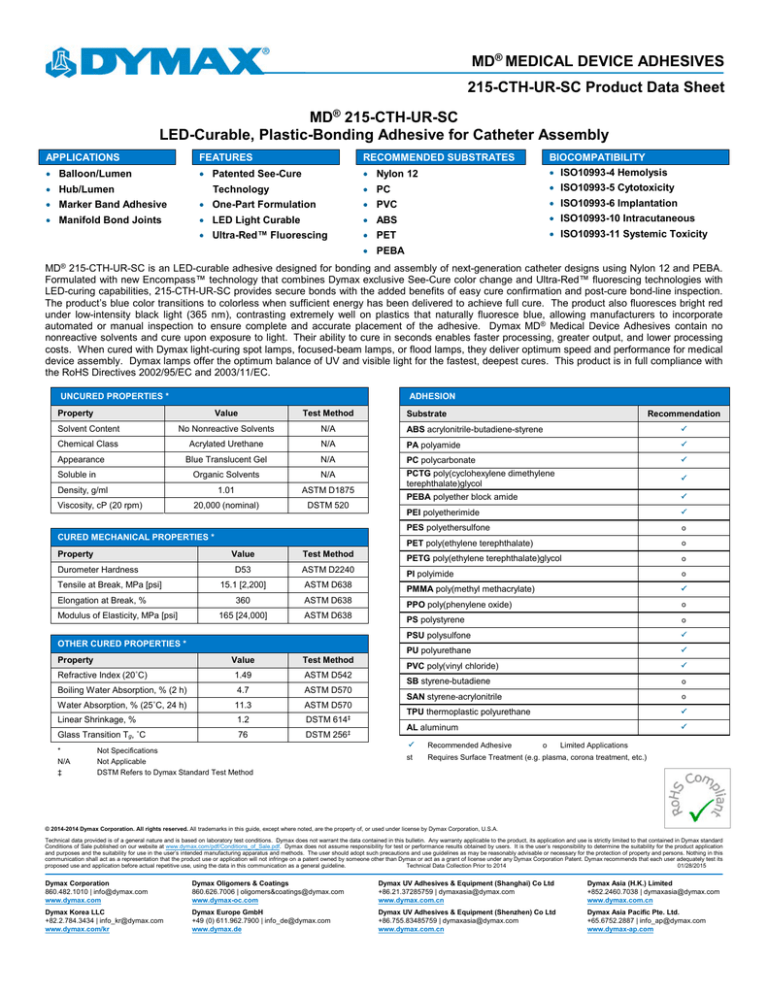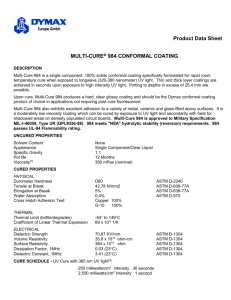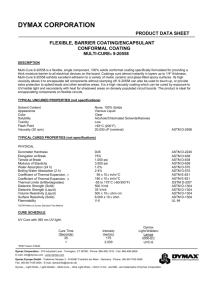
MD® MEDICAL DEVICE ADHESIVES
215-CTH-UR-SC Product Data Sheet
MD® 215-CTH-UR-SC
LED-Curable, Plastic-Bonding Adhesive for Catheter Assembly
APPLICATIONS
FEATURES
RECOMMENDED SUBSTRATES
BIOCOMPATIBILITY
• Balloon/Lumen
• Patented See-Cure
• Nylon 12
• PC
• ISO10993-4 Hemolysis
• ISO10993-5 Cytotoxicity
• Hub/Lumen
Technology
• Marker Band Adhesive
• One-Part Formulation
• PVC
• ISO10993-6 Implantation
• Manifold Bond Joints
• LED Light Curable
• ABS
• ISO10993-10 Intracutaneous
• Ultra-Red™ Fluorescing
• PET
• ISO10993-11 Systemic Toxicity
• PEBA
MD® 215-CTH-UR-SC is an LED-curable adhesive designed for bonding and assembly of next-generation catheter designs using Nylon 12 and PEBA.
Formulated with new Encompass™ technology that combines Dymax exclusive See-Cure color change and Ultra-Red™ fluorescing technologies with
LED-curing capabilities, 215-CTH-UR-SC provides secure bonds with the added benefits of easy cure confirmation and post-cure bond-line inspection.
The product’s blue color transitions to colorless when sufficient energy has been delivered to achieve full cure. The product also fluoresces bright red
under low-intensity black light (365 nm), contrasting extremely well on plastics that naturally fluoresce blue, allowing manufacturers to incorporate
automated or manual inspection to ensure complete and accurate placement of the adhesive. Dymax MD® Medical Device Adhesives contain no
nonreactive solvents and cure upon exposure to light. Their ability to cure in seconds enables faster processing, greater output, and lower processing
costs. When cured with Dymax light-curing spot lamps, focused-beam lamps, or flood lamps, they deliver optimum speed and performance for medical
device assembly. Dymax lamps offer the optimum balance of UV and visible light for the fastest, deepest cures. This product is in full compliance with
the RoHS Directives 2002/95/EC and 2003/11/EC.
UNCURED PROPERTIES *
ADHESION
Property
Value
Test Method
Solvent Content
No Nonreactive Solvents
N/A
ABS acrylonitrile-butadiene-styrene
Chemical Class
Acrylated Urethane
N/A
PA polyamide
Blue Translucent Gel
N/A
PC polycarbonate
Organic Solvents
N/A
1.01
ASTM D1875
PCTG poly(cyclohexylene dimethylene
terephthalate)glycol
PEBA polyether block amide
20,000 (nominal)
DSTM 520
Appearance
Soluble in
Density, g/ml
Viscosity, cP (20 rpm)
CURED MECHANICAL PROPERTIES *
Property
Durometer Hardness
Tensile at Break, MPa [psi]
Elongation at Break, %
Modulus of Elasticity, MPa [psi]
Value
Test Method
D53
ASTM D2240
15.1 [2,200]
PEI polyetherimide
PES polyethersulfone
o
PET poly(ethylene terephthalate)
o
PETG poly(ethylene terephthalate)glycol
o
o
ASTM D638
PMMA poly(methyl methacrylate)
360
ASTM D638
PPO poly(phenylene oxide)
o
165 [24,000]
ASTM D638
PS polystyrene
o
PSU polysulfone
PU polyurethane
PVC poly(vinyl chloride)
SB styrene-butadiene
o
Value
Test Method
Refractive Index (20˚C)
1.49
ASTM D542
Boiling Water Absorption, % (2 h)
4.7
ASTM D570
Water Absorption, % (25˚C, 24 h)
11.3
ASTM D570
Linear Shrinkage, %
1.2
DSTM 614‡
Glass Transition Tg, ˚C
76
DSTM 256‡
*
N/A
‡
Recommendation
PI polyimide
OTHER CURED PROPERTIES *
Property
Substrate
Not Specifications
Not Applicable
DSTM Refers to Dymax Standard Test Method
SAN styrene-acrylonitrile
o
TPU thermoplastic polyurethane
AL aluminum
Recommended Adhesive
st
Requires Surface Treatment (e.g. plasma, corona treatment, etc.)
o
Limited Applications
© 2014-2014 Dymax Corporation. All rights reserved. All trademarks in this guide, except where noted, are the property of, or used under license by Dymax Corporation, U.S.A.
Technical data provided is of a general nature and is based on laboratory test conditions. Dymax does not warrant the data contained in this bulletin. Any warranty applicable to the product, its application and use is strictly limited to that contained in Dymax standard
Conditions of Sale published on our website at www.dymax.com/pdf/Conditions_of_Sale.pdf. Dymax does not assume responsibility for test or performance results obtained by users. It is the user’s responsibility to determine the suitability for the product application
and purposes and the suitability for use in the user’s intended manufacturing apparatus and methods. The user should adopt such precautions and use guidelines as may be reasonably advisable or necessary for the protection of property and persons. Nothing in this
communication shall act as a representation that the product use or application will not infringe on a patent owned by someone other than Dymax or act as a grant of license under any Dymax Corporation Patent. Dymax recommends that each user adequately test its
proposed use and application before actual repetitive use, using the data in this communication as a general guideline.
Technical Data Collection Prior to 2014
01/28/2015
Dymax Corporation
860.482.1010 | info@dymax.com
www.dymax.com
Dymax Oligomers & Coatings
860.626.7006 | oligomers&coatings@dymax.com
www.dymax-oc.com
Dymax UV Adhesives & Equipment (Shanghai) Co Ltd
+86.21.37285759 | dymaxasia@dymax.com
www.dymax.com.cn
Dymax Asia (H.K.) Limited
+852.2460.7038 | dymaxasia@dymax.com
www.dymax.com.cn
Dymax Korea LLC
+82.2.784.3434 | info_kr@dymax.com
www.dymax.com/kr
Dymax Europe GmbH
+49 (0) 611.962.7900 | info_de@dymax.com
www.dymax.de
Dymax UV Adhesives & Equipment (Shenzhen) Co Ltd
+86.755.83485759 | dymaxasia@dymax.com
www.dymax.com.cn
Dymax Asia Pacific Pte. Ltd.
+65.6752.2887 | info_ap@dymax.com
www.dymax-ap.com
MD® MEDICAL DEVICE ADHESIVES
215-CTH-UR-SC Product Data Sheet
CURING GUIDELINES
The blue color of Dymax See-Cure products disappears when they are
fully cured. Full cure is achieved when additional light exposure does
not improve cured properties. The charts below provide information on
how long it takes to complete the transition from blue to clear using
different light sources and adhesive thicknesses.
Dymax Curing System
5000-EC (200 mW/cm2) B
(Intensity)
Adhesive Thickness, mm
Time to complete
[mil]
transition, s A
0.10 [4.0]
2
0.20 [8.0]
4
0.41 [16]
10
0.81 [32]
18
Dymax Curing System
(Intensity)
Adhesive Thickness, mm
[mil]
0.10 [4.0]
BlueWave® 200 (10 W/cm2) B, E
0.20 [8.0]
0.4
0.41 [16]
0.4
Time to complete
transition, s A
0.2
0.81 [32]
Dymax Curing System
(Intensity)
Adhesive Thickness, mm
[mil]
0.10 [4.0]
At 53 mm [2.1 in] focal distance. Maximum speed of conveyor is
8.2 m/min [27 ft/min]. Intensity was measured over the UVA range
(320-395 nm) using the Dymax ACCU-CAL™ 150 Radiometer.
E
Due to the distance between the end of the lightguide and adhesive,
intensity at the curing area was measured as 4.0 W/cm2.
OPTIMIZING PERFORMANCE AND HANDLING
1.
This product cures with exposure to UV and visible light.
Exposure to ambient and artificial light should be kept to a
minimum before curing. Dispensing components including
needles and fluid lines should be 100% light blocking, not just
UV blocking.
2.
All bond surfaces should be clean and free from grease, mold
release, and other contaminants prior to dispensing the
adhesive.
3.
Cure and color transition speed are dependent upon many
variables, including lamp intensity, distance from the light
source, required depth of cure, bond gap, and percent light
transmission of the substrate.
4.
Oxygen in the atmosphere may inhibit surface cure. Surfaces
exposed to air may require high-intensity (>150 mW/cm2) UV
light to produce a dry surface cure. Flooding the bond area with
an inert gas, such as nitrogen, can also reduce the effects of
oxygen inhibition.
5.
Parts should be allowed to cool after cure before testing and
subjecting to any loads.
6.
In rare cases, stress cracking may occur in assembled parts.
Three options may be explored to eliminate this problem. One
option is to heat anneal the parts to remove molded-in stresses.
A second option is to open the gap between mating parts to
reduce stress caused by an interference fit. The third option is
to minimize the amount of time the liquid adhesive remains in
contact with the substrate(s) prior to curing.
7.
Light curing generally produces some heat. If necessary,
cooling fans can be placed in the curing area to reduce the
heating effect on components.
8.
At the point of curing, an air exhaust system is recommended to
dissipate any heat and vapors formed during the curing
process.
BlueWave®
LED DX-1000 (385 nm)
Spot or Prime UVA (10 W/cm2) C,E
Time to complete
transition, s A
0.4
0.20 [8.0]
0.6
0.41 [16]
1
0.81 [32]
1
BlueWave®
Adhesive Thickness, mm
[mil]
0.10 [4.0]
LED DX-1000
VisiCure™ (405 nm) Spot
(10 W/cm2) C,E
Time to complete
transition, s A
0.4
0.20 [8.0]
1
0.41 [16]
2
0.81 [32]
3
Dymax Curing System
(Intensity)
Adhesive Thickness, mm
[mil]
0.10 [4.0]
UVCS Conveyor with Fusion F300
(2.5 W/cm2) D
Belt speed to complete transition,
m/min [ft/min] A
8.2 [27]
0.20 [8.0]
5.1 [17]
0.41 [16]
3.6 [12]
0.81 [32]
1.5 [5]
Dymax Curing System
(Intensity)
A
0.8
D
Curing through light-blocking substrates may limit the ability of See-Cure
adhesives to transition from blue to clear and may require longer light
exposure at critical wavelengths (320-400 nm for UV light curing;
320-450 nm for UV/Visible light curing). These times/speeds are typical
for curing through 100% light-transmitting substrates.
B
Intensity was measured over the UVA range (320-395 nm) using a
Dymax ACCU-CAL™ 50 Radiometer.
C
Intensity was measured over the UVA/Visible range (250-450 nm) using
a Dymax ACCU-CAL™ 50-LED Radiometer.
DISPENSING THE ADHESIVE
This material may be dispensed with a variety of manual and
automatic applicators or other equipment as required. Questions
relating to dispensing and curing systems for specific applications
should be referred to Dymax Application Engineering.
CLEANUP
Uncured material may be removed from dispensing components and
parts with organic solvents. Cured material will be impervious to
many solvents and difficult to remove. Cleanup of cured material
may require mechanical methods of removal.
PERFORMANCE AFTER TEMPERATURE EXPOSURE
Dymax light-curable materials typically have a lower thermal limit of
-54˚C [-65˚F] and an upper limit of 150˚C [300˚F]. Many Dymax
products can withstand temperatures outside of this range for short
periods of time. Please contact Dymax Application Engineering if
you need further assistance.
MD® MEDICAL DEVICE ADHESIVES
215-CTH-UR-SC Product Data Sheet
BIOCOMPATIBILITY
Polymerized Dymax MD® Medical Device Adhesives are biocompatibility
tested in accordance with ISO 10993 and/or USP Class VI. The
completed tests are listed on each product data sheet. Copies of the test
reports are available upon request. In all cases, it is the user’s
responsibility to determine and validate the suitability of these adhesives
in the intended medical device. These adhesives have not been tested
for prolonged or permanent implantation, and are only intended for use in
short-term (<29 days) or single-use disposable-device applications.
Dymax does not authorize their use in long-term implant applications.
Customers using these materials for such applications do so at their own
risk and take full responsibility for ensuring product safety and
biocompatibility.
STERILIZATION
Compatible sterilization methods include gamma irradiation and
ethylene oxide. Sterilization by autoclaving may be limited to certain
applications. It remains the user’s obligation to ascertain the effect of
sterilization on the cured adhesive.
STORAGE AND SHELF LIFE
Store the material in a cool, dark place when not in use. Do not expose
to light. This product may polymerize upon prolonged exposure to
ambient and artificial light. Keep covered when not in use. This
material has a six-month shelf life from date of shipment, unless
otherwise specified, when stored between 10˚C [50˚F] and 32˚C [90˚F]
in the original, unopened container.
GENERAL INFORMATION
This product is intended for industrial use only. Keep out of the reach
of children. Avoid breathing vapors. Avoid contact with skin, eyes, and
clothing. Wear impervious gloves. Repeated or continuous skin contact
with uncured material may cause irritation. Remove material from skin
with soap and water. Never use organic solvents to remove material
from skin and eyes. For more information on the safe handling of this
material, please refer to the Material Safety Data Sheet before use.


